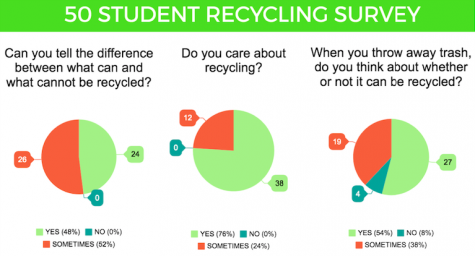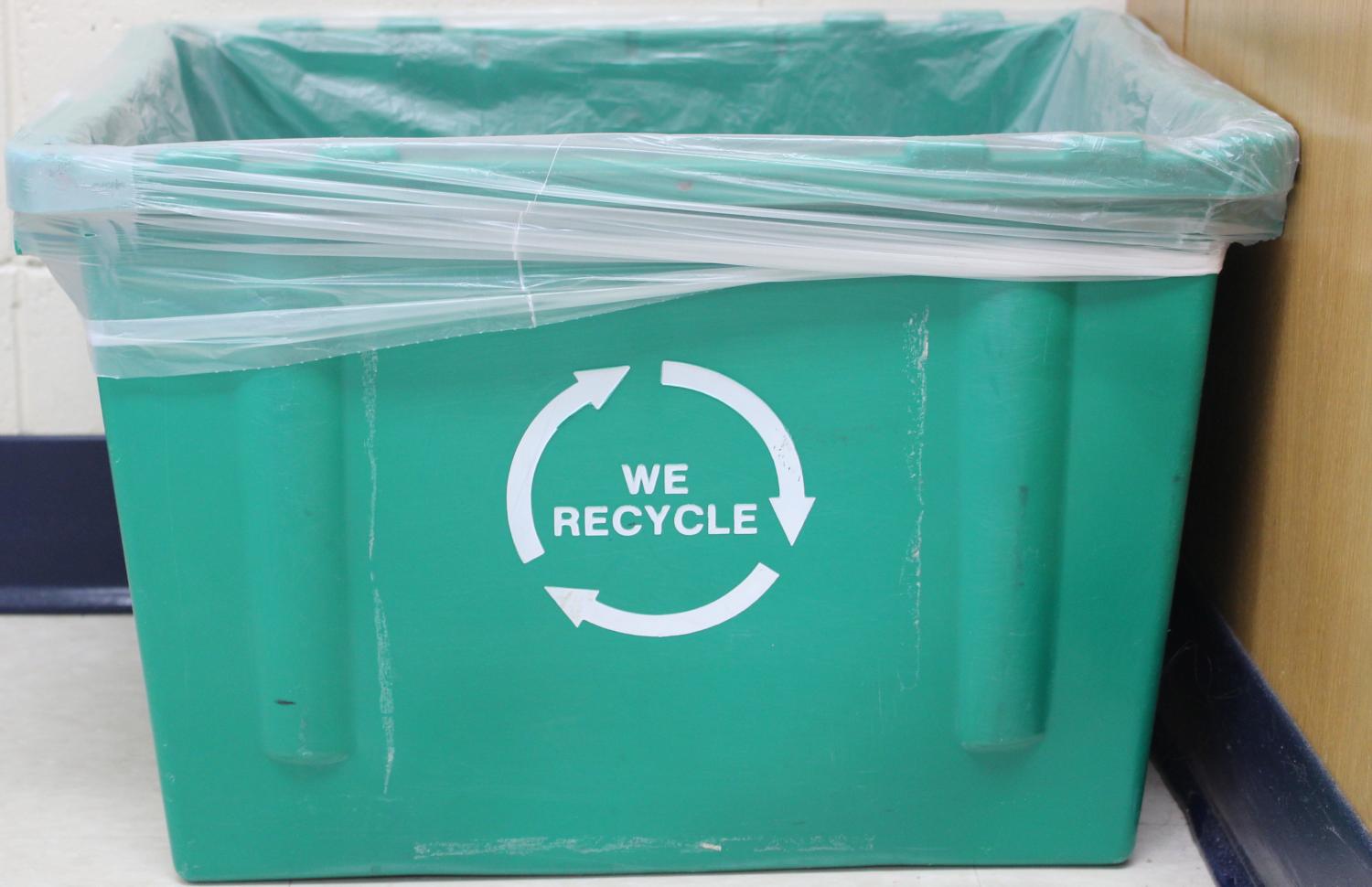Trash Talk: The reality about recycling at Homestead
June 6, 2017
Recycle Today for a Better Tomorrow
Save the planet.
Recycle more.
So how is Homestead pitching in to this nation-wide need?
The most important part of the trash disposal process is for people to make educated choices about where they are throwing away their trash while reducing their trash creation in general, in order to ensure recycling functionality at Homestead and in our state of Wisconsin.
Most students refuse to believe that Homestead legitimately utilizes the green recycling bins, located in every classroom, to recycle the trash inside. In a survey of 50 participants attending Homestead, 75% do not believe Homestead recycles, while only 25% affirmed the opposite.
Nancy Martinez Ramirez, senior, strongly believes the school has failed its recycling mission: “I feel like I speak for most of this school when I say that Homestead claims they recycle, but in the end of the day, they really don’t,” Ramirez said.
Ramirez holds these thoughts for many reasons including that if a recycling container gets ‘contaminated’ with general refuse waste, the container is no longer suitable to be recycled. Due to this reality, some of the staff at Homestead, including former long-time social studies teacher Mr. Brook Brown, believes that custodians and other cleaning staff don’t care about recycling. Teachers’ doubts about Homestead’s recycling process consequently influence students that Homestead does not recycle.
“It kills me to think that janitors throw away whole containers of recycled trash. Clean them out if they are contaminated; fix them, make them work,” Brown said.
Although custodians can easily dump a recycling bin in the general refuse trash can if appropriate, it is not accurate to assume that Homestead does not recycle in general. Currently, Homestead has a co-mingle recycling system, which means all paper fibers, plastics, metals and other containers are mixed in one recycling container and later sorted in a transfer station.
There are two big dumpsters by the receiving area; one is general refuse, which is non recyclable, and the other is strictly for recycling. The third, relatively bigger ‘miscellaneous dumpster’ takes all kinds of trash which is later taken to a transfer station where everything is dumped and sorted.
At night, custodians walk around with two trash cans, emptying and dumping trash accumulated in recycling bins and general refuse to the corresponding trash can. One is meant to be later thrown in the recycling dumpster while the and other in the general refuse dumpster.
Mr. Kyle Thompson, head of buildings and grounds for MTSD, assures Homestead does care about recycling: “We value recycling a lot. As facilities director, I’m in charge of safety, security, security, building, remodeling. Homestead has the largest budget in the district, so recycling offsets our cost tremendously,” Thompson said.
According to Thompson, it simply would not make sense for Homestead to omit recycling from its routine since it’s a lot less money for waste companies to pick up recyclable trash rather than general refuse. If we extrapolate the amount of money needed for trash pick up over the course of a year, we will spend $35,000s per year as a school in trash removal; if Homestead didn’t recycle, Thompson guarantees that the bill would probably go upwards to $60,000 per year.
“In one month, we spent $200 for recyclable trash to be picked up. About every three weeks, the non-recyclable waste dumpster is picked up for $1,200. It’s a whole lot more [money] if we are not recycling properly,” Thompson said.
In response to the general pessimism over the reality of certain recyclable containers going to the general refuse dump, Thomson answers with the hard truth: “What we don’t have is the ability with over a million square foot of buildings that we clean every night to sort through every single trash can that is out there. We just don’t have the labor force nor the funding to do something like that.”
Dave Kautzman, head custodian, emphasizes that, as overseer of the cleaning process at Homestead, the real problem is not whether or not we as a school recycle but rather if students are making conscious decisions when throwing away their trash.
“The biggest issue we would have [at Homestead] is with students who don’t place their items in the proper trash containers,” Kautzman said.
Thompson further emphasized the same concern: “We really need the help of the students to make sure that they are using recycling right in the field.”

In a survey of 50 students, more than half could only ‘sometimes’ distinguish whether or not their trash can be recycled. A small yet existent percentage of students only ‘sometimes’ cared about recycling. Only about half of the people surveyed think whether or not their trash can be recycled. This mentality indicates that educating minors about recycling is essential to guarantee a reliable process of recycling at Homestead.
“It is essential for students to understand that recycling is important. It’s about taking the responsibility, like many things in life, to take it upon yourself to do the right thing,” Kautzman said.
Wisconsin’s Role in Recycling
By simply throwing a piece of paper into a recycling bin or taking an old cell phone to the proper recycling facility, people can positively contribute to protecting the environment. Residents of Wisconsin live in the country’s fifteenth ‘greenest state’, according to Wallethub.com.
Wisconsin has tons of recycling units (RUs) that deal with waste management, one in each community, that the Wisconsin Department of Natural Resources (DNR) oversees. The purpose of these units is to have recycling processes, set up to reduce the amount of trash, available to the surrounding communities. Along with easy access, RUs must educate community members about the recycling process as well. At the end of each year, RUs must make a report to the DNR, which includes information about the amount of recycling materials that they collected.
The recycling process itself is very similar between local Wisconsin communities. Once recycling bins are picked up from houses or schools, they are then transported to one of the two hundred state- licensed composting facilities. There, the waste is regenerated into useable materials. Nowadays, composting is becoming a popular thing to do at home, so waste is easily and efficiently recycled in backyards.
In order to encourage recycling, Wisconsin has passed laws to ensure its functionality. More specifically, the Solid Waste Reduction, Recovery and Recycling Law, which was enacted in 1990, was designed to promote development of waste structures. During that time, around seventeen percent of solid waste was recycled, then, in 2004, the number increased to thirty six percent, statistics found from the Wisconsin DNR. Other key recycling legislation in Wisconsin make sure recycling bins are available inside or outside of public buildings; also, these laws prevent the burning of recyclable materials and littering.
Furthermore, Wisconsin placed many bans on a variety of items that can not be thrown away into general refuse waste containers and taken to landfills. A few of these items include paper, cardboard, electronics and appliances. These bans were put into effect for many reasons including the fact that items on the list can be recycled easily so they can be reused. Also, some of the items have toxic components that were going into the air and the ground; most importantly, recycling allows landfills to last longer while also preventing more pollution.
There are many benefits that come with recycling. For instance, it not only helps the environment but also helps the economy. The value of all the materials that were recycled so that they could be reused was about sixty nine million dollars in 2013, as found by the Wisconsin DNR. The amount of jobs the recycling industry provides also helps the economy. In addition, the effects recycling has on the environment are critically beneficial. Composting allows for an efficient way to keep soil healthy and increase growth. Recycling reduces the amount of materials that go to landfills to be burned, thus it reduces the CO2 emissions into the atmosphere.
Although recycling has many advantages, it is actually not the best option to choose. Reusing is the a better alternative to throwing away trash since, in that scenario, nothing is being thrown away. However, the best solution is simply reducing. By reducing the amount amount of trash created, people are able to significantly lower the amount of trash that could go to the landfill.
“Recycling is not the best option. If you recycle a water bottle it is just going to be turned into a bag, which could end up in a landfill anyways. I think if our state worked on reduction, we would probably be a little better off,” Dawn Pfaff, science teacher, said.
According to environmentalists and Pfaff, it is safe to conclude that, in order for Wisconsin to become an even greener state, it is essential people put a heavier focus on reducing their trash in addition to reusing and recycling.
